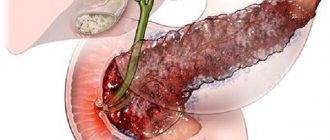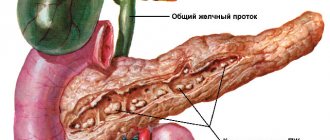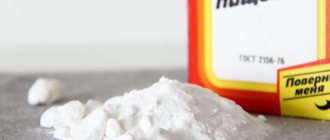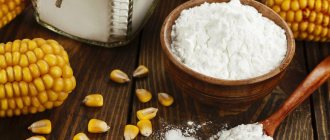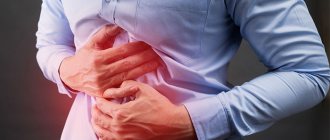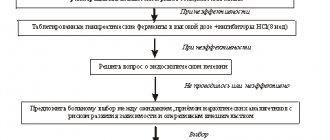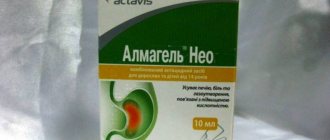How to treat cholecystitis and pancreatitis
Acute or chronic pancreatitis and cholecystitis are treated comprehensively. Therapy includes a diet plan, medication, and physical therapy.
Therapeutic diet
Diet is the first and main therapeutic measure.
To cure cholecystitis and pancreatitis during an exacerbation, you need to follow 3 principles: cold, hunger and rest.
If in the acute course of the disease the patient is prescribed hunger, cold, rest, then in chronic pancreatitis patients are advised to eat properly:
- Eat small portions up to 7 times a day. Food should be warm.
- Avoid fatty foods, fried foods, smoked foods, hot spices, alcohol, chocolate, and soda.
- Steam dietary meat and chop before use.
- Include low-fat fermented milk products, vegetable stews, cereal soups and porridges in the menu.
- After eating, you should move for half an hour to increase the flow of bile and improve the digestion of food.
Dietary nutrition helps reduce the load on the gallbladder and pancreas, get rid of pain and heaviness in the abdomen.
Drug treatment
List of drugs to treat cholecystitis and pancreatic insufficiency:
- Kontrikal, Antagozan - inhibitors of pancreatic enzymes. Drugs are prescribed in acute cases of the disease to suppress the secretory function of the gland.
- Methyluracil, Pentoxyl are anabolic agents indicated for improving metabolic processes in the body.
- Omeprazole, Cimetidine - to reduce gastric secretory function.
- Festal, Pancreatin are enzyme preparations necessary for the breakdown of food mass in the intestines into nutrients.
- Bactrim, Biseptol - these antibiotics for cholecystitis and pancreatitis are indicated to be taken to eliminate inflammation, especially if it was caused by an infection.
- Holosas, Cholenzym are choleretic agents that improve the outflow of bile from the bladder and its ducts.
- No-shpa, Papaverine, Motilium - relieve muscle spasms, relieve pain.
Folk remedies
Herbs for pancreatitis and cholecystitis improve the functions of the digestive system. Healing infusions for the treatment of gallstones and pancreas most often include chamomile, plantain, wormwood, immortelle, marigold, yarrow and other medicinal plants.
Effective folk remedies for pancreatitis and cholecystitis:
- Mix 1 tbsp. l. wormwood, immortelle flowers, yarrow and fennel seeds. Brew one tablespoon of raw material with 500 ml of boiling water, let it brew for 8 hours. Strain. Take 1 tbsp. l. during the day. The need and duration of treatment for an inflamed bladder must be agreed with a herbalist.
- Mix in equal parts crushed burdock and elecampane roots, marigolds, wormwood, St. John's wort, chamomile, string, sage and horsetail. Pour a large spoonful of the mixture into a thermos and pour 0.5 liters of boiling water. After 2 hours, strain. Drink the medicine for pancreatic insufficiency daily, 100 ml 30 minutes before meals.
Additional Methods
It is impossible to completely cure chronic pancreatitis. Ultrasound heating of the abdomen helps to enhance the effect of drug treatment and accelerate the onset of remission. For inflammation of the gall bladder, electrophoresis is also prescribed (an easily digestible form of the drug penetrates the skin under the influence of direct current) to the liver area. This enhances the production of liver secretions and improves blood supply to the organ. About 10 sessions are required.
?rel=0″>
To facilitate the functioning of the digestive system, patients are prescribed to drink medicinal mineral waters of Borjomi, Essentuki, and sea water baths saturated with carbon dioxide. After the inflammation has been relieved, mud therapy and medicinal applications are prescribed for the area where the liver and pancreas are located.
When is surgery necessary?
Surgery on the gallbladder is prescribed if there are large calcifications in it that cannot be broken down by medications. Large stones can completely block the lumen of the excretory duct, which will negatively affect the functioning of the liver and pancreas. In such cases, the patient requires emergency surgery to remove them.
You cannot do without the help of a surgeon if pancreatitis is complicated by a purulent-necrotic process. In this case, the affected part of the gland is removed and drainage tubes are placed.
Drug treatment
To suppress the infection that provoked the inflammatory process, antibiotics such as Biseptol are prescribed.
To eliminate the conditions for the proliferation of bacteria, it is necessary to establish the outflow of enzymes from the inflamed organs and stop stagnation; antibiotics cope with this. With cholecystitis, disruption of bile flow may be associated with:
with spasm of the bile ducts and then antispasmodics are prescribed - No-shpu, motilium, papaverine;
with excessive relaxation of the gallbladder, as a result of which the organ is unable to contract and eject bile. In such cases, drugs that have a choleretic effect are prescribed - cholagol, holosas, eglonil, cisapride.
With pancreatitis, two problems are also possible - too low production of pancreatic juice, then antispasmodics or hypersecretion of the pancreas are prescribed, and then the following medications are prescribed:
To improve digestion, enzyme preparations are prescribed - mezim, pancreatin, cotazim, digestal, pancitrate and the like. For cholecystitis, without concomitant pancreatitis, bile preparations may be prescribed. The main thing is that antibiotics do not cause complications.
During the acute period of illness, the doctor may prescribe fasting in the first days. At this time, it is recommended to drink plenty of fluids, preferably clean water, and move as little as possible.
Rest will reduce blood flow in the organs, which will allow the pancreas or gallbladder to quickly return to normal; this is how you can treat the gland in a unique way. But even with the chronic course of the disease, it is necessary to follow certain principles in nutrition. The rules are simple:
- - small meals, 5-6 times a day, the last meal no later than 3 hours before bedtime;
- - cottage cheese and fermented milk products, vegetables and vegetable soups, porridges are healthy;
- — it is better to steam meat and fish;
- - prohibited: alcohol, chocolate, cocoa;
- — it is necessary to limit the consumption of smoked meats, fatty, spicy, fried foods.
Food should be warm, not scalding. It is not recommended to go to rest immediately after eating - this weakens the flow of bile. It's best to walk for about 30 minutes.
Pancreatitis and cholecystitis cause sharp pain after eating. By following a diet, you can not only reduce pain, but also stop the progression of the disease.
Directions and recommendations for the use of the drug
Allohol is a completely natural drug, so a doctor may prescribe it when pregnant or during the lactation period. But you should be attentive to the state of your body and, if you have the slightest concern, immediately visit your doctor.
As for the question “can children take Allohol for pancreatitis?”, the drug is approved from a young age. The dosage depends on how impaired the outflow and formation of bile is. Typically, children under seven years of age are recommended to take half a tablet three times a day. Children over seven years old - a whole tablet three times a day.
Children should take the drug under close supervision from their parents. The medication should be taken only after meals. Otherwise, it can provoke the appearance of gastritis or ulcers, as well as seriously disrupt digestion.
When combining alcohol-containing drinks or tinctures with this medicine, the following are possible: severe nausea and diarrhea, as well as pain in the bladder area. At the first appearance of such symptoms, you should contact your healthcare provider for help.
During treatment with Allochol, you should stop drinking alcoholic beverages. They are contraindicated in case of pancreatitis and can cause serious disorders in the body.
Interaction of Allochol with other drugs:
- When taken together with diuretics, the secretion of the choleretic tract increases.
- When taking groups of vitamins, their absorption into the body improves.
- In combination with laxatives, they help eliminate the problem of constipation.
- It has a positive effect on the processes of eliminating infection and inflammation in combination with antibiotics.
Reviews about the natural product
Reviews about taking the drug Allohol for pancreatitis are in most cases positive. This is due to the diuretic effect of the drug. It also gently relieves pain and unpleasant symptoms that accompany diseases of the bladder and biliary tract. Many note the complete elimination of symptoms such as flatulence, constipation, bitter taste in the mouth and pain.
Antibacterial agents
Antibiotics for cholecystopancreatitis are taken to suppress the growth and reproduction of pathogenic bacteria that cause inflammation, as well as to prevent complications if there is a risk of their occurrence. However, they are prescribed with caution, since they have many side effects, contraindications, and cause the formation of resistance in pathogenic microflora when taken for a short time.
Tetracycline tablets
Antibiotics are usually used to eliminate inflammation, although they are highly toxic. The main requirement for the drug is the ability to accumulate and create therapeutic concentrations in bile, pancreas and gall tissues.
The following antibiotics are prescribed:
- Tetracycline;
- Ofloxacin;
- Ampicillin;
- Biseptol;
- Bactrim;
- Ceftriaxone;
- Olethetrin;
- Rifampicin.
The course of antibiotic therapy is 7–10 days. The choice of drug, treatment regimen, and exact dosages are determined by the doctor.
Important: For a quick onset of effect, use injection routes of administration (intravenously or intramuscularly) of antibiotics. For not very severe forms of the disease, oral administration is possible.
Gepabene
Extracts of the fruits of milk thistle and the herb fumitory are used as active substances. Produced by the German company Merckle in the form of capsules for oral administration.
The drug normalizes the amount of secreted bile, relieves spasm of the ducts, and facilitates the flow of bile into the intestines. Restores cells (hepatocytes), protects them from damaging substances.
Not used to treat children and adolescents under 18 years of age.
Used with meals. Per dose: 1 capsule, 3 times a day.
Note! The integrity of the capsule must not be damaged; it must be taken whole without chewing. . For pain at night, take an additional 1 capsule before bed. The maximum daily dose is 6 capsules. The duration of therapy is determined individually by the attending physician
For pain at night, take an additional 1 capsule before bed. The maximum daily dose is 6 capsules. The duration of therapy is determined by the attending physician individually.
Phytotherapy
Treatment of chronic pancreatitis or cholecystitis is often supplemented with herbal medicine. Herbs that have a beneficial effect on the digestive system: yarrow, calendula, chamomile, mint, plantain and others. Below are recipes for medicinal preparations.
Recipes for medicines for cholecystitis
Now you will learn how to treat cholecystitis with herbs:
- Mix the following dry herbs in equal quantities (1 tablespoon each): wormwood, mint, yarrow, fennel fruit, immortelle. Pour boiling water (0.5 l) over the prepared mixture and leave for 8 hours. Take this herbal medicine in small sips throughout the day.
- Mix immortelle flowers (1 tsp), triphol leaves (1 tbsp) and mint (1 tsp). Pour boiling water (0.5 l) over this mixture and boil for 10 minutes over low heat. Take 100 ml before meals 3 times a day. The decoction taken will help remove the inflammatory process, improve the functioning of the gastrointestinal tract, and eliminate the symptoms of cholecystitis.
Herbal recipes for pancreatitis
It's time to learn how to treat pancreatitis with herbs. Popular treatments for pancreatitis are:
- A mixture of yarrow, immortelle, St. John's wort, mint, fennel, rose hips. Mix all the herbs (take 10 g of each component), take 1 tablespoon of herbal mixture, pour boiling water (0.5 l) over it, leave for 12 hours. It is best to infuse the medicinal mixture in a thermos. Then strain and drink 150 ml 3 times a day half an hour before meals.
- A disease such as pancreatitis is successfully treated with the help of a collection for which you will need the following components: elecampane root, St. John's wort, calendula, burdock, wormwood, chamomile, horsetail, string, sage leaves. Take 1 tablespoon of these ingredients. Mix all ingredients, pour boiling water, leave and take exactly the same as in the previous paragraph.
You can take medicinal herbal preparations only when a person is sure there is no allergic reaction to the herbs. You also need to know that some medications can cause constipation or diarrhea, while others can lower or increase blood pressure. Therefore, herbal medicine should only be prescribed by a doctor.
The principles of treatment, just like the symptoms of cholecystitis and pancreatitis, have much in common. With proper timely treatment, you can do without conservative therapy. With the help of complex treatment: medications, diet, herbal medicine, the recovery process will occur very quickly.
Proper nutrition will help
In case of chronic disease of these organs, it is necessary to treat not only with medications, but also to help the body, to remove the symptoms of chronic pancreatitis in women with the help of proper nutrition.
- Acute stage of pancreatitis. The pain that goes away at this time does not allow the patient to eat any food. Symptoms can be eliminated during this period by complete fasting. The only thing you can drink is clean water. But if this is an acute form of cholecystitis, then there is no need to follow a diet. But the food should be lean.
- In case of inflammation of the pancreas, it is recommended to add more protein to your regular diet. It is what limits the development of the fat layer, and also improves the body’s protection of the liver and the functioning of the gallbladder. Foods that contain large amounts of protein: fish, meat, eggs. All this must be steamed. And also low-fat cottage cheese.
- In case of chronic disease of the digestive system, carbohydrate intake must be limited. You can only eat potatoes, cereals, and bread. They are difficult to absorb into the body, so they can be consumed in limited quantities. But easily digestible carbohydrates are not allowed. This is due to an increase in the thickness of bile.
- Fats are also among the foods that are not good for you. When treating the pancreas, it is necessary to completely eliminate fats of animal origin; they are replaced with vegetable fats. They help break down cholesterol. They promote intensive outflow of bile from the gallbladder. Also, no additional fats are used for frying. Aldehydes, which are released during this process, cause damage to cells and digestive organs. Diet is very important for diseases of the gallbladder and pancreas
- Salt. Its intake must be limited. This helps reduce the inflammatory process.
- It is necessary to take microelements and vitamins in food. These can be vitamins such as A, B2, B6, B12, C and calcium. These can be either drugs purchased at a pharmacy or food products. It is the lack of calcium that leads to disruption of the functioning of the pancreas and the occurrence of chronic disease. It also promotes the timely outflow of bile and reduces the risk of developing cholesterol crystals. Calcium is available in tablet form. This medicine must be taken several times a day.
- You cannot eat cocoa, canned food, soybeans, beans, wheat, rice, or canned food. Replenishing the body with magnesium helps relieve spasms, as well as increased irritability of nerve fibers and painful sensations. You can take magnesium in the form of medicine or food.
- You need to drink plenty of water every day. It is necessary for all cells of the body, and especially the digestive organs. For example, water helps increase the outflow of bile and improve the functioning of the pancreas and liver. Mineral water has a good effect on the body. Treatment of a chronic disease is never possible without drinking water.
- You should not eat foods that are rich in fiber. During the treatment of these disorders, by adhering to these rules and following a dietary diet, you can reduce the need for taking.
What are diseases?
Pancreatitis and cholecystitis are diseases of the digestive system, characterized by damage and inflammation of its secretory organs responsible for the production of special enzymes that are necessary for the breakdown of food. The joint development of diseases most often has a chronic course and is due to the fact that the bile produced by the liver stagnates in the gallbladder, and at the same time the outflow of pancreatic secretions worsens. The latter, due to its aggressiveness, begins to “eat” the gland from the inside. Gastroenterologists associate the occurrence of such a pathological condition with the direct influence of the following factors:
- unbalanced diet, frequent dry snacks and excessive content of easily digestible carbohydrates and animal fats in the daily menu,
- serious gastrointestinal diseases that disrupt the functioning of the digestive system,
- frequent stress, causing nervous tension and provoking the development of dangerous diseases,
- alcohol dependence, which contributes to toxic damage to secretory organs,
- obesity, increasing intra-abdominal pressure.
These are the main provoking factors due to which the pancreas and gallbladder are simultaneously destroyed, which impairs their functioning. Less common is the medicinal type of pathology associated with uncontrolled use of certain medications. This cause of the disease is detected mainly in people who constantly self-medicate.
Gallstones can also cause the disease. They completely block its duct, which is combined at the outlet with the pancreatic one, which provokes a delay in the secretory digestive organs of aggressive secretions. This leads to their simultaneous inflammation and destruction. The patient's diagnosis in this case indicates the gallstone type of disease.
The most dangerous is the simultaneous influence on the human body of several negative factors that provoke the development of cholecystopancreatitis. In this case, the risk of developing a complicated form of diseases of the secretory organs, which is quite easily susceptible to malignancy, increases significantly.
Features of the course of cholelithiasis and pancreatitis
Most often in clinical practice, biliary type of pancreatitis and acalculous cholecystitis occur simultaneously. The symptoms accompanying them are very similar, so only an experienced gastroenterologist can make the correct diagnosis, or rather, identify the inflammation of which organ was the root cause of the pathological condition. But any person should know the warning signs indicating the development of a dangerous combined disease, as this will help identify it in a timely manner and significantly increase the patient’s chances of a full recovery. Among the most common signs of cholecystopancreatitis, practicing doctors highlight the following:
- heaviness and acute pain localized in the right hypochondrium and radiating to the left side or back,
- dyspeptic intestinal disorders (diarrhea followed by prolonged constipation),
- constant nausea, interspersed with attacks of breakthrough vomiting,
- feeling of dryness and bitterness in the mouth.
These are general signs indicating that an inflammatory process begins in the pancreas and gall bladder. But in these manifestations there are also specific differences that indicate to the specialist which of the secretory organs has suffered more, for example, with cholecystitis, the pain is stronger on the right, and if the pancreas is inflamed, on the left. They help the attending physician in prescribing and adjusting the correct medication treatment.
In the event that a person has at least one such symptom, or even worse, several, it is necessary to immediately seek advice from a practicing gastroenterologist.
A doctor of this qualification will help make the correct diagnosis, on the basis of which an adequate course and treatment regimen will be selected, allowing the patient to be relieved of the pathology in a short time and prevent its aggravation.
Treatment with drugs
The functioning of the pancreas is closely related to the gallbladder. If the functions of one of the organs are impaired, the normal functioning of the other is impossible. Therefore, treatment of cholecystitis of various types and pancreatitis of any stage is carried out simultaneously, and these diseases are usually treated with medications and for a very long time.
medication treatment
Drug treatment of pancreatitis, as well as cholecystitis, is the main means of getting rid of them. It consists of taking medications of different spectrum of action, which are determined by the doctor. Usually they prescribe drugs that will be equally useful for the restoration of both organs.
Today, any medical research method shows that the cause of cholecystitis is infection. Therefore, in its treatment, the third generation of cephalosporins (Ceftibuten, Cefotaxime, Ceftibuten) is used.
Antibiotics
antibiotics
Antibacterial therapy is indicated if there is stagnation of bile, the walls of the gallbladder and pancreas are inflamed. The drug is prescribed in the form of tablets or intramuscular injections. Penicillins are effective in counteracting microbes. To get rid of staphylococci, gram-negative microbes on which they have no effect, Gentamicin injections are used. Patients are often prescribed Amoxicillin, Clarithromycin, and Ampiox.
The antibiotic "Bactrim" effectively suppresses infections. The suspension is taken twice a day before meals with measuring spoons (1 each if the phase of the disease is chronic, 6 – with an exacerbation). The course of treatment is at least 5 days. Another antibiotic, Biseptol, is considered a safe but powerful remedy. Prescribed for 4 days with a daily dose of 480 mg 2 times or once 960 mg (chronic course), 3 times during exacerbation.
Choleretic agents
It is possible to treat at any stage of the disease with choleretic drugs. Since bile from the bladder penetrates the pancreas, provoking its inflammation, reflux must be prevented. The problem is solved by using agents that cause the production of bile and prevent it from stagnating.
choleretic agents
Choleretic drugs for pancreatitis and cholecystitis are offered by pharmacists of several types, differing in their effect on liver function. The popular drug “Eglonil” is prescribed 3 times a day, 50 mg. The course of treatment is 4-6 weeks. Minimal intake during pregnancy is allowed.
The medicine in the form of a solution "Holosas" helps to cope with cholecystitis. Classic dosage - 2.5 ml (children), 5 ml (adults) 2-3 times a day 30 minutes before meals. For pregnant women - only on the initiative of a gastroenterologist.
Antispasmodics
The most famous drugs that reduce pain are: “No-shpa”, “Tramal”, “Ketanov”, “Spazmagol”. Motilium tablets are often used, prescribed to adults and children over 5 years of age (if they weigh over 20 kg). Take 10 mg 2-3 times a day half an hour before meals, the duration is determined by the doctor. The dose is adjusted if the patient has kidney or liver diseases.
Cholekinetics
These are drugs that help release stagnant bile from the bladder. For example, magnesium sulfide.
The load on both organs is well reduced by taking medications: Mezim, Pantprozol, Digestal, Festal, Creon. The inhibitor "Omeprazole", which is responsible for the production of pancreatic secretions, is prescribed in doses of 20 mg (or 40 mg for severe exacerbation) 1 time/day for a course of 1 month - 6 weeks. Take in the morning before or during meals.
cholekinetics
Pancreatin tablets are actively used for cholecystitis and pancreatitis. The safety of the product allows it to be taken even by children under one year old. Reception up to several months. The standard daily dose for adults is 400 thousand units, for children 1.5 years -16 years old it is 4 times less. The drug normalizes well, facilitates the digestion process and is therefore often prescribed by doctors.
Physiotherapeutic treatment
Pancreatitis and cholecystitis can be successfully treated with the help of physiotherapeutic measures, for example, UHF, ultrasound, electrophoresis.
We also recommend viewing: How to replace sugar for pancreatitis and cholecystitis?
Treatment of pancreatitis and cholecystitis with ultrasound, UHF or electrophoresis is quite successful, since these procedures increase bile production, improve local blood circulation, reduce pain, eliminate inflammation, and prevent the formation of stones.
The only difference in physiotherapeutic treatment is that with a diagnosis of “chronic pancreatitis” the patient is given a therapeutic lotion on the left side of the abdomen, and with a diagnosis of “chronic cholecystitis” - on the right side.
Joint treatment of these diseases also involves the use of mineral waters, for example, “Essentuki”, “Borjomi”.
Therapeutic mud is also a very good remedy for chronic cholecystitis and pancreatitis. They are able to relieve inflammation in the pancreas and gall bladder, relieve pain, and increase immunity.
Simultaneous use of allochol in combination with other drugs
When using allohol, the possibility of interaction of the drug with medications taken should be taken into account. The combination of incompatible substances will cause irreparable harm to the body. At the same time, the beneficial properties of some drugs, on the contrary, are enhanced
Pay attention to the features of drug interactions:
- Use together with drugs containing aluminum hydroxide, cholestipol or cholestyramine is ineffective. These substances, reacting with beneficial acids, neutralize them.
- Use simultaneously with drugs that enhance bile production increases the positive effect of taking it.
- Simultaneous use with medications that have a laxative effect helps to get rid of long-term constipation.
- The use of allochol together with fat-soluble vitamins promotes their better absorption.
- In combination with antibiotics, the anti-inflammatory process is enhanced.
Thus, this drug can be taken with almost all known medications, with a few exceptions. Combination with many agents enhances the beneficial effects.
Diagnostics
In the early stages, chronic pancreatitis and cholecystitis are difficult to diagnose, as they have mild symptoms. The diagnosis is made by a gastroenterologist based on a clinical examination, laboratory and instrumental examination:
- general blood test - reveals the inflammatory process;
- biochemical blood test - determines the level of enzymes;
- blood sugar test - indicates the presence of glucose;
- stool analysis (coprogram) - shows the degree of digestion of fats and proteins;
- Ultrasound of the abdominal cavity;
- gastroscopy.
Less commonly performed:
- cholecystocholangiography of the gallbladder;
- endoscopic retrograde cholangiopancreatography (ERCP);
- CT scan.
Need to know
Painful sensations in chronic cholecystopancreatitis can be caused by:
- inflammatory processes near nerves;
- pancreatic tissue destruction, which can be triggered by various factors;
- narrowing of the bile duct.
A disruption in the production of certain hormones can cause a chronic illness, in which the process of digesting fats can be significantly disrupted, which is why they can even be excreted in unprocessed form along with feces.
At the initial stages of development of inflammatory processes of the pancreas, the patient may have impaired glucose tolerance.
It may not cause any symptoms at first and can only be detected by laboratory tests.
If you seek medical attention promptly, a diagnosis can be made before your blood sugar levels rise above normal.
One of the main signs of high blood sugar is deformation of the fundus vessels.
In severe cases, when lactic acid accumulates in the gastrointestinal tract, the patient may experience signs of complications of diabetes mellitus. If the blood glucose level reaches 200 mg/dl, the patient experiences damage to the nerve fibers, nervous system disorders, and mental illness may occur.
There are also more rare symptoms indicating a disease such as chronic cholecystopancreatitis:
- yellowing of the skin;
- ascites;
- protrusion of the pleural part;
- formation of false cysts;
- arthritis, which affects the small joints of the hands.
According to nosology, deaths are 50%
Therefore, it is important not to self-medicate. Only a doctor knows how to treat these diseases correctly
The likelihood of death may increase if the patient has the following complications:
- formation of blood clots in the veins;
- significant obstruction of the bile duct;
- the presence of malignant neoplasms in the pancreatic duct;
- damage to peripheral nerve fibers;
- diseases of the endocrine system.
When examining a patient with chronic cholecystopancreatitis, the doctor may detect a white coating on the tongue, “seizures” in the corners of the mouth, excessive dryness of the skin, and delamination of the nail plates. The presence of red spots on the abdominal cavity may indicate poor circulation.
Additional recovery methods
When chronic cholecystitis and pancreatitis occur, mechanical action is necessary to drain excess bile.
Mineral water
Tubage according to Demyanov. For treatment, you need to take a glass of magnesia or warm non-carbonated mineral water with the addition of soda in the morning on an “empty” stomach. After taking the medicine, the patient must return to bed and place a heating pad on the right rib. This will help remove stagnation of bile and lead the blood flow to the pancreas and liver.
Folk remedies help very well in treating the pancreas and liver. It helps relieve symptoms. These can be tinctures and decoctions of corn , stigmas , clover , dandelion , knotweed and Chinese callus . They will help eliminate the inflammatory process, reduce symptoms and improve the functioning of the gastrointestinal tract.
You need to drink 2-2.5 liters of water per day.
Eat no less than 5 times a day. Portions should be small. One should fit in the palm of an adult. You cannot eat fried, smoked or spicy foods.
Using diet, medications and folk recipes for pancreatitis, you can treat these organs several times faster.
Features of the appointment of Pancreatin
Pancreatitis may be accompanied by excessive or insufficient enzymatic activity of the gland. If increased secretion occurs, drugs are prescribed to stabilize the pancreas. If the gland is sluggish and has low activity, the doctor prescribes Pancreatin to compensate for the lack of enzymes. Pancreatin is an extract of the pancreas of cattle. The drug comes in the form of tablets. If the organ is functioning normally, no medicine is prescribed. Treatment is usually limited to drugs against cholecystitis.
If chronic cholecystitis is accompanied by pancreatitis, an enzyme preparation is prescribed to relieve the pancreas. Sometimes cholecystitis causes the need to remove the diseased gallbladder. After surgery, the digestion process becomes difficult. In this case, Pancreatin is prescribed, which significantly alleviates the patient’s condition.
Like any medicine, Pancreatin has contraindications. You can take the enzyme preparation as prescribed by your doctor, following all the instructions.
When treating pancreatitis, the drug Panzinorm Forte or Pancreatin combined can be used. The medicine contains cholic acids. The drug can be prescribed by a doctor at a medical institution. Self-administration can lead to exacerbation of liver pathology associated with insufficient bile formation. The use of Pancreatin is excluded for a number of diseases:
- Acute inflammatory processes in the bile ducts or ducts, cholelithiasis.
- Hepatitis.
- Liver failure.
- Blockage of the bile ducts by a cyst or tumor.
- Functional liver disorders.
You should take the medicine as prescribed by your doctor. The patient is prescribed laboratory tests, ultrasound, tomography. Based on the data obtained, the specialist makes a conclusion about the condition of the pancreas, bile ducts and liver. A gastroenterologist has the necessary knowledge about the structure of internal organs and the relationship between the 2 diseases.
Features of therapy
It is immediately worth noting that such ailments of the digestive system cannot be self-medicated. You will have to seek professional medical help in any case, but only by doing this in a timely manner does the patient have every chance of a speedy recovery.
Attempts to cure the disease on your own, listening to the advice of incompetent people, are rarely crowned with success.
Since medications are the main component of the therapeutic course, it is necessary to know which drugs are most often prescribed for the development of pathologies.
Of course, the first symptoms cannot be an incentive to go to the pharmacy and purchase everything listed below. However, being aware of the general treatment plan makes it much easier to comply with all the doctor’s instructions.
What are diseases?
- A disease in which inflammation occurs in the pancreas is called pancreatitis. Due to the occurrence of a pathological process in this organ, an insufficient number of vital enzymes is produced, without which the digestion of food becomes problematic. Pancreatitis significantly complicates the patient’s life; the main role in this is played by the painful symptoms of the disease.
- The second disease - cholecystitis - inflammation of the gallbladder, is also characterized by the occurrence of inflammation, often being infectious in nature. The risk group for developing the disease is considered to be overweight people with gallstone disease. Choleretic medications and vitamins are the first thing that is prescribed to patients with cholecystitis, but more on that later.
The role of proper nutrition in the treatment of illnesses
Of course, antibiotics, choleretic drugs, vitamins and other tablets determine the speed of recovery, preventing the development of complications.
Even with regular use of the appropriate medication, the following diseases often contribute to the occurrence of diseases:
- excessive portions of food;
- lack of consistency in eating;
- abuse of bad habits (tobacco, alcohol);
- improper nutrition;
- stress and anxiety.
Strictly following the prescriptions of specialists and basic adherence to food intake rules can stop the further development of pathologies. A healthy person who does not have a history of confirmed illnesses only needs to monitor their eating style.
Ongoing events
The first thing a doctor prescribes to a patient with this disease is antibiotics. They are needed in order to get rid of the infection that could cause the disease. During the treatment of chronic cholecystitis and pancreatitis, many drugs are prescribed to relieve unpleasant symptoms; treatment consists of the use of painkillers and antispasmodics.
The attending physician prescribes some medications that improve digestion. Using tablets containing analogues of human digestive enzymes, you can get rid of steatorrhea and prevent some enzymes from getting into the feces. If there is a deficiency of bile, the doctor prescribes choleretic drugs.
Drug treatment of cholecystitis and pancreatitis is primarily aimed at the following measures:
- normalization of the production of pancreatic enzymes with special medications;
- elimination of foci of inflammation;
- ridding a person of complications that have developed as a result of the disease;
- restoration of the patient's performance.
To cleanse the body of harmful substances, the doctor may prescribe certain types of mineral waters, which are recommended to be consumed 5 times a day, 1 glass. Physiotherapeutic procedures, diet and medicinal herbs for pancreatitis will help speed up recovery.
What is the relationship between pancreatitis and cholecystitis?
Chronic cholecystitis and pancreatitis are ailments of the digestive system. Pancreatitis is a disease of the pancreas, and cholecystitis is an inflammation of the gallbladder.
In the body, these organs work together, they release enzymes into the digestive tract for the normal processing of any food by the intestines. At the same time, bile produced by the liver accumulates in the gallbladder, and the pancreas independently produces a digestive enzyme - pancreatic (pancreatic) juice.
With cholecystitis and pancreatitis, the functioning of these organs of the digestive system deteriorates. So, with cholecystitis, bile begins to stagnate in the gallbladder, and an inflammatory process occurs. And with pancreatitis, gastric juice remains in the pancreas and it begins to digest itself. Also, with pancreatitis, juice can enter the gallbladder and then it begins to corrode its walls. That is why it is believed that cholecystitis and pancreatitis are diseases that complement each other.
Causes of diseases
The disease can develop for several reasons, including the following:
- constant presence of infection in the nose, throat and larynx;
- problems with metabolism, which can be caused by errors in nutrition and the presence of gastrointestinal diseases;
- development of diabetes mellitus;
- slight mobility of the patient;
- constant constipation and disorders;
- overweight and obesity;
- slight tone of internal organs;
- unhealthy diet, which can be rich in flour, fried and salty foods;
- insufficient caloric nutrition, which can even lead to anorexia;
- consumption of large amounts of spicy foods;
- excessive alcohol consumption;
- frequent food poisoning or intoxication of the body with other harmful substances.
Attention!
It is very dangerous when a person accumulates several factors at once, which can lead to the development of cholecystitis and pancreatitis. In such cases, there is a possibility of developing a complicated form of the disease, which can even lead to cancer Pancreatitis Cholecystitis
What are the signs to distinguish diseases?
The symptoms and treatment of pancreatitis and cholecystitis have many similarities; only a doctor can make a correct diagnosis.
General symptoms of cholecystitis and pancreatitis:
- Vomiting, nausea.
- Pain syndrome.
- Temperature increase.
- Appearance of sticky sweat.
A person who does not have a medical education will not be able to correctly diagnose himself. Only a narrow specialist - a gastroenterologist - knows the difference between these diseases. The main difference between the ailments is that with pancreatitis the patient has more pain in the left side of the abdomen, and with cholecystitis the pain radiates to the right side, since that is where the gallbladder is located. These diseases may also differ in such characteristic symptoms as dry mouth. It is characteristic of pancreatitis. But bitterness in the mouth is a sign of cholecystitis.
We also recommend viewing: Features of diet No. 5 for pancreatitis
